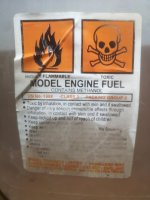Recrystallising P2NP
The main reason for recrystallisation is to increase the yield of certain reductions by removing any unreacted aldehydes in this case benzaldehyde, if you are working with amounts >0.5 mole, then we recommend at least one recrystallisation, although it is not essential.
It is a simple process and product losses are less than 5% instead of the more usual 20 to 25% loss in many organic chemistry recrystallisations.
PPE: Ideally wear a pair of disposable nitrile gloves underneath a pair of butyl gauntlets, at a minimum two pairs of disposable nitrile gloves.
Recrystallize using 99.5%+ isopropanol at 60°C / 140°F (no higher).
Note: Weigh empty flask, weigh IPA in a measuring cylinder, weigh P2NP on scales, weigh after addition of product to calculate losses of IPA through evaporation, and at the end weigh final amount of dry product after all crops to calculate your yield.
In an erlenmeyer flask (reduces product loss through evaporation):
Add P2NP at 2 g / ml of isopropanol (even though alot more can dissolve in 1 ml isopropanol, purity would be reduced).
Once dissolved, hot filter any undissolved contaminants if required, filter through your buchner funnel using a fast filter paper or higher porosity frit and have a little additional isopropanol already at 60°C / 140°F to rinse any crystals on filter/frit, then cover your erlenmeyer flask with film or foil with a couple of small air holes either side.
Allow to cool to room temperature by placing in a dry dark undisturbed place at least for a few hours after which you will see yellow crystals forming, move to the refrigerator for a few hours before filtering the crystals that will have formed.
Return filtrate (mother liquor) to refrigerator for a day to allow the remaining crystals to drop out of solution, if you know there is negligible water content within the filtrate you can place in a freezer to speed formation of crystals (if there is any water content this is not such a good idea as you get slushy darker crystals.
Ideally use a Buchner funnel with fast filter paper or higher porosity frit to filter the pale yellow crystals, return filtrate to freezer for additional crops, then rinse with ice-cold isopropanol (save this filtrate for future rinses, and collect crystals formed within it from time to time), finally rinse with distilled water to remove any catalyst and allow to vacuum dry in funnel for 10 minutes (the water filtrate is disposed of).
Finally vacuum dry crystals in buchner funnel for 15 minutes, once dry, weigh crystals and carefully transfer to an air-tight PP container and place in cold storage.
The above recrystallisation procedure can be repeated another couple of times to be able to achieve a purity of 99%.
There should be no orange crystals or red product - rinsing with ice-cold isopropanol will remove any outer layers of red polymerised product.
Note: The warmer the storage temperature the quicker nitrostyrene's polymerize. Viable crystals can be stored in a refrigerator (0 to 5°C / 30 to 40°F) for 6 months, or a freezer (-5 to -15°C / 20 to 5°F) for 2 years or more.
If you do not have a buchner funnel and vacuum source, then you will have to gravity filter, using beaker that a funnel can sit on, place 2 coffee filters and pour crystal and IPA mixture in, now place everything in a refrigerator to filter and then dry before storing.

